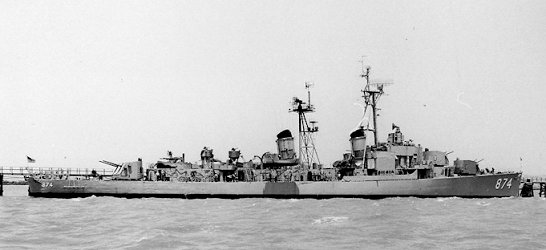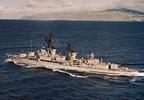

 |
Search the Site with

|
 | Sorry, no coat of arms available. |
USS DUNCAN was one of the GEARING - class destroyers and the third ship in the Navy to bear the name. Reclassified DDR 874 in 1949, the ship became DD 874 again in January 1969. Decommissioned on January 15, 1971, and stricken from the Navy list on September 1, 1973, the DUNCAN was sunk as a target off southern California on July 31, 1980.
| General Characteristics: | Awarded: 1942 |
| Keel laid: May 22, 1944 | |
| Launched: October 27, 1944 | |
| Commissioned: February 25, 1945 | |
| Decommissioned: January 15, 1971 | |
| Builder: Consolidated Steel Corp., Orange, Tx. | |
| FRAM II Conversion Shipyard: Long Beach Naval Shipyard, Long Beach, CA | |
| FRAM II Conversion Period: October 1960 - June 1961 | |
| Propulsion system: four boilers, General Electric geared turbines; 60,000 SHP | |
| Propellers: two | |
| Length: 391 feet (119.2 meters) | |
| Beam: 41 feet (12.5 meters) | |
| Draft: 18.7 feet (5.7 meters) | |
| Displacement: approx. 3,400 tons full load | |
| Speed: 34 knots | |
| Aircraft after FRAM II: none | |
| Armament after FRAM II: three 5-inch/38 caliber twin mounts, Mk-32 ASW torpedo tubes (two triple mounts), two Hedgehogs Mk-10 | |
| Crew after FRAM II: approx. 275 |
Crew List:
This section contains the names of sailors who served aboard USS DUNCAN. It is no official listing but contains the names of sailors who submitted their information.
USS DUNCAN Cruise Books:
USS DUNCAN History:
USS DUNCAN was launched 27 October 1944 by Consolidated Steel Corp., Orange, Tex.; sponsored by Mrs. D. C. Thayer; and commissioned 25 February 1945, Commander P. D. Williams in command.
DUNCAN, converted to a radar picket destroyer during her postshakedown overhaul, sailed from Norfolk 2 June 1945 for the Pacific, and after touching at San Diego and Pearl Harbor, joined CABOT (CVL 28) for screening and plane guard duty during the strikes on Wake Island of 1 August. After calling at Eniwetok, she continued to Okinawa to join the 7th Fleet for patrol duty off the Chinese and Korean coasts during the landing of occupation troops at Tsingtao, Taku, and Jinsen. DUNCAN served in the Far East on occupation duty until 25 March 1946 when she sailed for the west coast, arriving at San Diego 28 April.
For the next year DUNCAN trained along the west coast, keeping high her operational skills and readiness. In May 1947 she departed San Diego for a 5-month cruise to the Far East, where she visited Okinawa, Japan, and China. On her return to the States, DUNCAN resumed coastal operations with both aircraft and submarines. On 1 March 1948 she suffered 2 killed and 14 injured in a magazine explosion on board. After repairs at Long Beach, Calif., the destroyer rejoined the fleet for training until January 1949, when she again sailed for the western Pacific, this time for 8 months. While deployed she was reclassified DDR 874 on 18 March 1949.
DUNCAN operated between San Diego and Pearl Harbor until November 1950 when she steamed into Korean waters to join the 7th Fleet in its unremitting projection of sea power against Communist aggression. DUNCAN served a total of three tours off Korea during the fighting in that ravaged land. She sailed as plane guard for carriers and as antisubmarine escort for battleships; she fired shore bombardments in support of minesweepers and to interdict enemy communications; she patrolled against North Korean minesweepers and fishing craft. Through all she added her significant contribution to the vast and indispensable sea-borne support of the United Nations troops ashore. During this time, DUNCAN earned seven battle stars and a Korean Presidential Unit Citation.
Following her return to the states in 1952, DUNCAN underwent a shipyard overhaul which included installation of heightfinder radar. From 1953 to 1960, DUNCAN continued the routine of WESTPAC duty and training exercises out of her home port in San Diego. In October 1960, she entered Long Beach Naval
Shipyard to commence an extensive fleet rehabilitation and modernization overhaul (FRAM II), which extended DUNCAN's useful life 10 years.
In 1961, DUNCAN joined Destroyer Squadron Nine as flagship while the squadron was homeported in Yokosuka, Japan. DUNCAN returned to San Diego in 1964. During the remainder of 1964 and through the summer of 1965, DUNCAN operated as a school ship for FTC San Diego, as well as participating in major
fleet exercises. In August 1965 as a unit of Destroyer Squadron Seventeen, DUNCAN once again sailed off to war for the 3rd time, this time to Vietnam. She saw action as a unit of Operation Sea Dragon in the fall of 1965 and spring of 1966. She returned to San Diego in June 1966, but by December was on her way
back to Vietnam. She was once again assigned to Operation Sea Dragon and was credited with destruction of over 190 enemy logistics craft and the rescue of a downed aviator. DUNCAN was taken under fire by North Vietnamese shore batteries on several occasions but luckily was never hit. These actions earned her the Combat Action Ribbon and a COMSEVENTHFLT citation.
Following return to San Diego in 1967, DUNCAN conducted training exercises and surveillance operations before entering Long Beach Naval Shipyard in March 1968 for overhaul. In November 1968, DUNCAN deployed once again to the 7th Fleet. Thirty days later she was on the gunline off Vietnam delivering gunfire against Viet Cong targets. During the ensuing three months DUNCAN expended nearly 200 tons of ammunition at various targets in South Vietnam and the DMZ in support of U.S., Vietnamese, Korean and Australian forces. In March 1969, DUNCAN joined USS RANGER (CVA 61) for the remainder of the cruise conducting special operations in the Sea of Japan and Yellow Sea. Highlights of the cruise were returning to the states via Australia, crossing the equator, navigating aII four quadrants of the earth and sighting APOLLO 11's reentry near Pago Pago, American Samoa.
From June 1969 to March 1970 DUNCAN operated out of her home port of San Diego. March again saw DUNCAN cross the Pacific for duty with the 7th Fleet. DUNCAN performed Korean Patrol duties during the Iater part of March and first half of April until diverted to conduct surveillance of a Russian Task Force. May through August were months in which DUNCAN showed her true mettle hurling over 4000 rounds of five inch ammunition at the Viet Cong insurgent forces while firing in direct support of Allied Forces. DUNCAN fired missions from the DMZ to the Cambodian border, steaming into waters plyed previously only by the ''brown water Navy'' in the steamy Mekong Delta regions. During this period DUNCAN also performed screen commander duties for the USS AMERICA (CVA 66) in the Tonkin Gulf . DUNCAN returned to San Diego for the last time in September after traveling over 42,000 miles during her final six month deployment.
USS DUNCAN's Commanding Officers:
| Period | Name |
|---|---|
| February 1945 - July 1946 | Commander P. D. Williams, USN |
| July 1946 - May 1948 | Commander P. Van Leunen, Jr., USN |
| May 1948 - August 1949 | Commander J. R. North, USN |
| August 1949 - December 1951 | Commander E. G. Sanderson, USN |
| December 1951 - December 1952 | Commander R. H. Smith, USN |
| December 1952 - September 1954 | Commander R. E. Lawrence, USN |
| September 1954 - June 1956 | Commander E. E. Conrad, USN |
| June 1956 - May 1958 | Commander P. S. Smith, USN |
| May 1958 - September 1959 | Commander L. M. Smith, USN |
| September 1959 - December 1960 | Commander H. E. Thornhill, Jr., USN |
| December 1960 - March 1961 | LCDR E. J. Messere, USN |
| March 1961 - March 1963 | Commander W. B. Althoff, USN |
| March 1963 - June 1964 | Commander M. E. Soper, USN |
| June 1964 - October 1965 | Commander J. E. Weatherford, USN |
| October 1965 - March 1968 | Commander S. W. Birch, USN |
| March 1968 - December 1969 | Commander C. R. Stephen, USN |
| December 1969 - October 1970 | Commander R. L. Turnage, USN |
| October 1970 - January 1971 | LCDR J. A. Carbone, USN |
About the Ship's Name:
Silas Duncan born in Rockaway, N.J., in 1788, was appointed midshipman 15 November 1809. While third lieutenant of SARATOGA during the Battle of Lake Champlain, 11 September 1814, he was sent in a gig to order the gunboats to retire. He succeeded in delivering the orders despite concentrated enemy fire which severely wounded him and caused the loss of his right arm. For his gallant conduct he was thanked by Congress. From 1818 to 1824 Commander Duncan saw active service on board INDEPENDENCE, HORNET, GUERRIERE, CYANE, and FERRET. He died 14 September 1834 at White Sulphur Springs, W. Va..
Accidents aboard USS DUNCAN:
| Date | Where | Events |
|---|---|---|
| March 1, 1948 | eastern Pacific | USS DUNCAN suffers a magazine explosion killing two and injuring 14. The destroyer subsequently enters Long Beach Naval Shipyard, Long Beach, Calif., for repairs. |
USS DUNCAN Documents:
Plan of the Day from February 14, 1967 |  |
 |  |  |  |  |  |  |  |
USS DUNCAN Image Gallery:
 |  |
 Back to Destroyers list.
Back to Destroyers list.  Back to ships list.
Back to ships list.  Back to selection page.
Back to selection page.  Back to 1st page.
Back to 1st page.